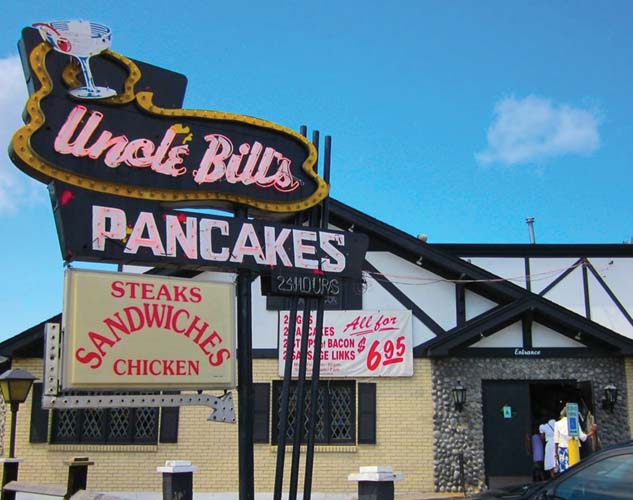
south st. louis | Everybody who’s anybody, and millions of nobodies, worked in food service at one time or another. Although U.S. presidential candidate Vice President Kamala Harris may not have McDonald’s on her LinkedIn profile, she worked there. As a part-time anybody, this grizzled old reporter’s food service experience includes two nights as a steakhouse dishwasher and about two weeks sweating as a Jack-In-The-Box grill man. The ‘drunk rush’ at the drive-thru at about 2 a.m. was not to be believed. I’m sure that was the case every morning for the harried servers at the late, lamented Uncle Bill’s Pancake House, too—although it hadn’t been open all night for quite some time, the neon sign outside still indicated that it was serving 24 hours. It was a frequent last stop for a date and me sometime in the wee hours after a night on the town. But the iconic inn-like restaurant closed Oct. 8 after having served countless metro residents fluffy pancakes, crisp bacon, hashbrowns and good coffee since the early 1960s. You couldn’t really call yourself a St. Louisan unless you’d been there. “Uncle Bill” was Bill Ernst, who’d opened the joint as a bar that wasn’t faring too well when a friend and customer, the story goes, suggested he convert it into a pancake house. The rest is history for metro residents. Marriage proposals have been accepted or declined in the cozy confines of Uncle Bill’s. Many teenagers got their first kiss in a booth there. It was where rowdy groups went after prom because their plans included being out all night. Church-goers gathered for breakfast or lunch, no matter how many needed to be seated or when they arrived. Waiting in line, which sometimes snaked outside, guests noticed the unique walls of smooth, lacquered stones, round and oblong, perhaps like a ski lodge; some diners were delighted or amused by the religious figurines in the display case just inside the entrance. Long live Uncle Bill’s. The location on Manchester Road in west county will remain open—until 10 p.m. Night owls, there’s always Waffle House.

the metro
Not all that long ago, it seemed, a new craft brewery popped up every month in the metro. Now, they’re closing or declaring bankruptcy faster than you can say Jack Robinson. I’d only gotten to the middle syllable of ‘Robinson’ on the morning of Oct. 8, when I learned Earthbound Beer was planning to shut down its ‘nano-brewing’ experiment Nov. 22, after 10 years operating at two addresses on Cherokee Street in St. Louis. Hell of a way to celebrate your 10th anniversary. Producing only several hundred barrels annually, nano-brewing is an even more conservative approach to the art of mixing hops and barley, adding yeast and holding your breath for who knows how long than a microbrewery, of which two others have landed on the rocks in recent months. (Of course, every other StL beermaker is a microbrewer in comparison to Anheuser-Busch.) In September, O’Fallon Brewery in Maryland Heights quietly announced its closing on social media, noting that all its equipment, from fermentation tanks to canning and bottling equipment, would be up for auction through Oct. 23. The timing is especially unfortunate, because the craft brewery—one of the region’s largest—was known for its pumpkin beer. O’Fallon had filed for bankruptcy protection in June 2023, citing the pandemic as one reason for slumping sales. Earlier in September 2024, the metro’s fourth-largest brewer, Urban Chestnut, filed bankruptcy and announced plans to reorganize under a different investor. It produced 24,000 barrels in 2023.

ladue
St. Louis County Library (SLCL) will host the 45th annual St. Louis Storytelling Festival from Nov. 13, to Nov. 23, featuring performances by eight nationally renowned storytellers, along with a variety of other programs and presenters. This year’s line-up will include bilingual performances, indigenous storytelling, folklore, writing workshops and more. There are 24 total events planned, all are free and open to the public. Festival events will take place at a variety of venues throughout the metro, including the Clark Family Branch on Lindbergh in Ladue and select other SLCL branch locations, the Missouri History Museum, St. Louis Art Museum, Work & Leisure and the Mirowitz Center. You may also capture your personal history throughout the festival in the Emerson History & Genealogy Center’s Personal History Studio at the Clark branch. Alternatively, invite a family member or friend to engage in a meaningful conversation, capturing the stories in the studio. Prompts will be available and staff will be on hand to help get you started. Appointments are required, as well as a USB flash drive or external hard drive for storage. And if anyone gets hungry at lunchtime Nov. 16, three food trucks will be parked outside the Clark branch from 11 a.m. to 1 p.m: Zacchi, The MOObile and The Sweet Side. A complete schedule of events is available at slcl.org/storytelling.

 notable neighbor
notable neighbor
downtown
The Campbell House, a museum at 1508 Locust downtown, was built in 1851 and owned by wealthy merchant Robert Campbell and his descendants from 1854 until 1938, most of the historical period that Mark Twain satirized in his 1873 novel The Gilded Age, characterizing the rampant graft, materialism and political corruption of the time. The area was in a new-moneyed neighborhood then known as Lucas Place, and most of the visible excess was inside. Immediately to the left of the entry hallway, the living room is decorated and furnished with most of the original colors, patterns and pieces from the late 19th century. If not over the top, it’s very busy—crowded, at least. Andy Hahn, the museum’s executive director, smiles and nods: “That was the aesthetic.” Hahn came by his position honestly. Raised in Webster Groves, after graduating from DeSmet, he went on to earn a history degree at SLU. To underline, then highlight his affinity for history, he’s just had a book published that tells the history of St. Louis via 40 rare maps: Mapping St. Louis. The book will make its debut at The Campbell House on Oct. 20 in a launch event from 3 to 6 p.m. Many of the maps in Hahn’s beautiful volume are manuscripts—hand-drawn surveyor’s maps. Others display the evolution of water and sewer systems in the city center. Another illustrates how our city wards shrank from 28 to 14. One shows how the Mississippi’s channel was redirected closer to the levee to aid in steamboat traffic as a result of dikes engineered by none other than Lt. Robert E. Lee, the future Confederate military leader. “Silt had accumulated at the levee, and the dikes jiggered the river toward the city, washing away the silt, and an island,” says Hahn. That was just what Lee had intended—a brilliant engineer, he’d predicted that the channel would eventually be obstructed, forcing the river, and commerce, toward the Illinois shore. Maps show Bellefontaine Cemetery, the interior of the art museum and the Zoo. An elaborate map toward the end of the book reflects dreams, not reality. It projects a possible future expansion of Metro’s light-rail system. “To the west, [one terminus] would have been at Wentzville,” he says. “To the east, it would have ended at Carlyle Lake.” All that was missing was many billions of dollars and the fervent will of the people. Neither was present, or may ever be. Maps need cartographers, of course, and one whom Hahn refers to as “legendary” was Joseph Cromwell Brown, who charted many of the growing city’s “common fields,” agricultural plots for families with surnames like Laclede and Chouteau. Brown was also the man who sketched many of the state lines throughout the Louisiana Purchase that weren’t determined by geographical features like the Mississippi and Missouri rivers. The Iowa-Missouri state line is an example of a border drawn by Brown. Presentations and book signings will continue through February. For detailed information about Hahn’s fascinating and unique workplace, visit campbellhousemuseum.org.








